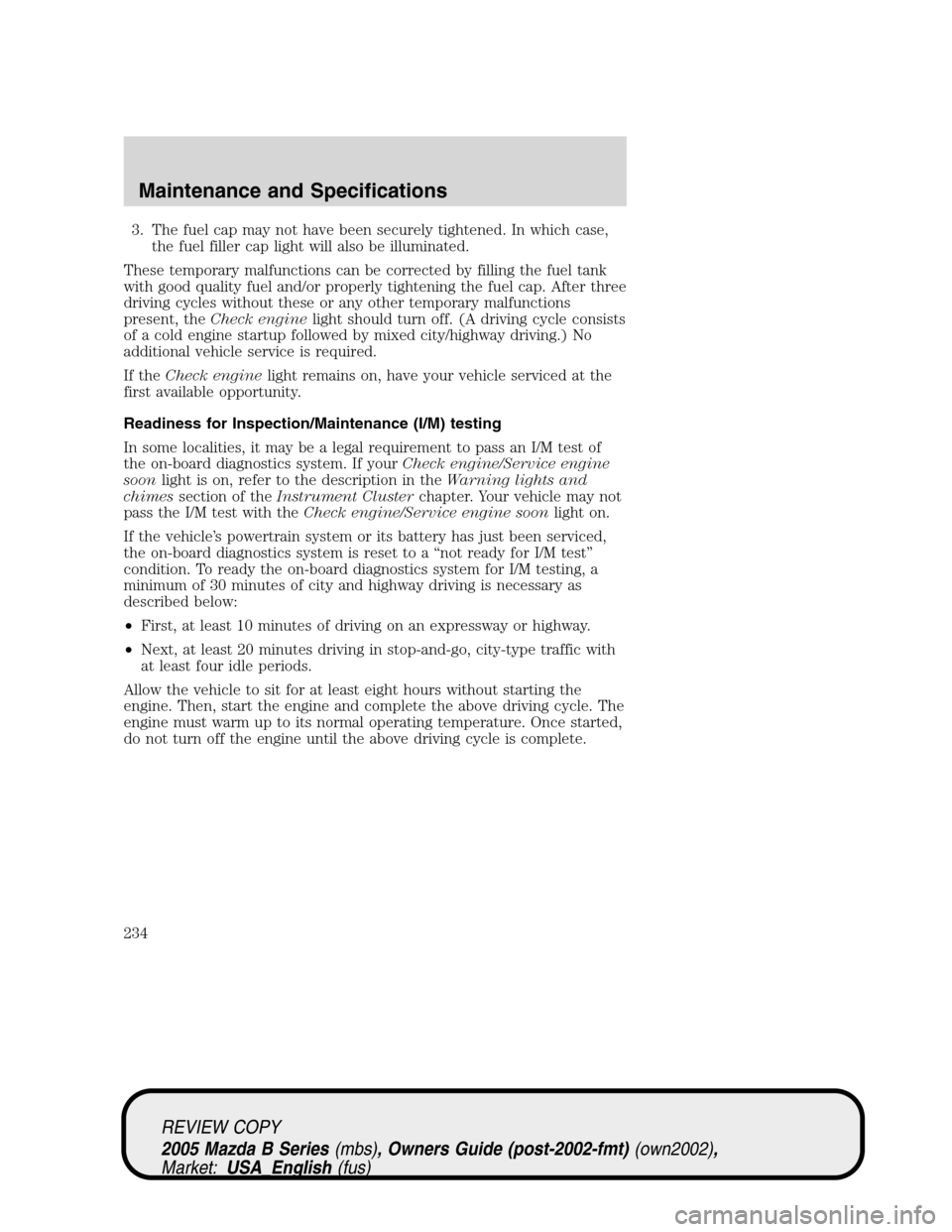service reset MAZDA MODEL B2300 TRUCK 2005 Owners Manual (in English)
[x] Cancel search | Manufacturer: MAZDA, Model Year: 2005, Model line: MODEL B2300 TRUCK, Model: MAZDA MODEL B2300 TRUCK 2005Pages: 257, PDF Size: 2.8 MB
Page 152 of 257

3. Start the vehicle.
If it is necessary to use the above procedure to move the gearshift lever,
it is possible that a fuse has blown or the vehicle’s brakelamps are not
operating properly. Refer toFuses and relaysin theRoadside
Emergencieschapter.
WARNING: Do not drive your vehicle until you verify that the
brakelamps are working.
WARNING:
Always set the parking brake fully and make sure the
gearshift is latched in P (Park). Turn the ignition to the LOCK
position and remove the key whenever you leave your vehicle.
WARNING: If the parking brake is fully released, but the brake
warning lamp remains illuminated, the brakes may not be
working properly. See your authorized Mazda dealership.
Driving with a 5–speed automatic transmission (if equipped)
This vehicle is equipped with an adaptive Transmission Shift Strategy.
Adaptive Shift Strategy offers the optimal transmission operation and
shift quality. When the vehicle’s battery has been disconnected for any
type of service or repair, the transmission will need to relearn the normal
shift strategy parameters, much like having to reset your radio stations
when your vehicle battery has been disconnected. The Adaptive
Transmission Strategy allows the transmission to relearn these operating
parameters. This learning process could take several transmission
upshifts and downshifts; during this learning process, slightly firmer
shifts may occur. After this learning process, normal shift feel and shift
scheduling will resume.
WARNING: Hold the brake pedal down while you move the
gearshift lever from P (Park) to another position. If you do not
hold the brake pedal down, your vehicle may move unexpectedly
and injure someone.
REVIEW COPY
2005 Mazda B Series(mbs), Owners Guide (post-2002-fmt)(own2002),
Market:USA_English(fus)
Driving
151
Page 223 of 257

How Limp to Safety works
If the engine begins to overheat:
•The engine coolant temperature
gauge will move to the red (hot)
area.
•The
symbol will illuminate.
•TheCheck engineindicator light
will illuminate.
If the engine reaches a preset over-temperature condition, the engine
will automatically switch to alternating cylinder operation. Each disabled
cylinder acts as an air pump and cools the engine.
When this occurs the vehicle will still operate. However:
•The engine power will be limited.
•The air conditioning system will be disabled.
This system has given you an early warning of engine damage and you
should immediately drive to a place of safety where the engine can be
cooled or the vehicle towed to a service shop. Continuing to drive in this
Limp to Safety mode will increase engine temperature some more,
increasing the chance of engine damage, and:
•The engine will completely shut down.
•Steering and braking effort will increase.
If you have decided not to have the vehicle towed, and when the engine
temperature cools, you try to re-start it and it appears to have returned
to normal operation, don’t delay in getting to a service facility as soon as
possible to diagnose what caused the overheat and prevent further
engine damage.
When Limp to Safety mode is activated
You have limited engine power when in the Limp to Safety mode, so
drive the vehicle with caution. The vehicle will not be able to maintain
high speed operation and the engine will run rough. Remember that the
engine is capable of completely shutting down automatically to prevent
engine damage, therefore:
1. Pull off the road as soon as safely possible and turn off the engine.
2. Arrange for the vehicle to be taken to a service facility.
3. If this is not possible, wait for the engine to cool down.
4. When the engine has cooled down, first check the coolant level. If
low, then use a rag and carefully turn the cap one notch
REVIEW COPY
2005 Mazda B Series(mbs), Owners Guide (post-2002-fmt)(own2002),
Market:USA_English(fus)
Maintenance and Specifications
222
Page 235 of 257

3. The fuel cap may not have been securely tightened. In which case,
the fuel filler cap light will also be illuminated.
These temporary malfunctions can be corrected by filling the fuel tank
with good quality fuel and/or properly tightening the fuel cap. After three
driving cycles without these or any other temporary malfunctions
present, theCheck enginelight should turn off. (A driving cycle consists
of a cold engine startup followed by mixed city/highway driving.) No
additional vehicle service is required.
If theCheck enginelight remains on, have your vehicle serviced at the
first available opportunity.
Readiness for Inspection/Maintenance (I/M) testing
In some localities, it may be a legal requirement to pass an I/M test of
the on-board diagnostics system. If yourCheck engine/Service engine
soonlight is on, refer to the description in theWarning lights and
chimessection of theInstrument Clusterchapter. Your vehicle may not
pass the I/M test with theCheck engine/Service engine soonlight on.
If the vehicle’s powertrain system or its battery has just been serviced,
the on-board diagnostics system is reset to a“not ready for I/M test”
condition. To ready the on-board diagnostics system for I/M testing, a
minimum of 30 minutes of city and highway driving is necessary as
described below:
•First, at least 10 minutes of driving on an expressway or highway.
•Next, at least 20 minutes driving in stop-and-go, city-type traffic with
at least four idle periods.
Allow the vehicle to sit for at least eight hours without starting the
engine. Then, start the engine and complete the above driving cycle. The
engine must warm up to its normal operating temperature. Once started,
do not turn off the engine until the above driving cycle is complete.
REVIEW COPY
2005 Mazda B Series(mbs), Owners Guide (post-2002-fmt)(own2002),
Market:USA_English(fus)
Maintenance and Specifications
234